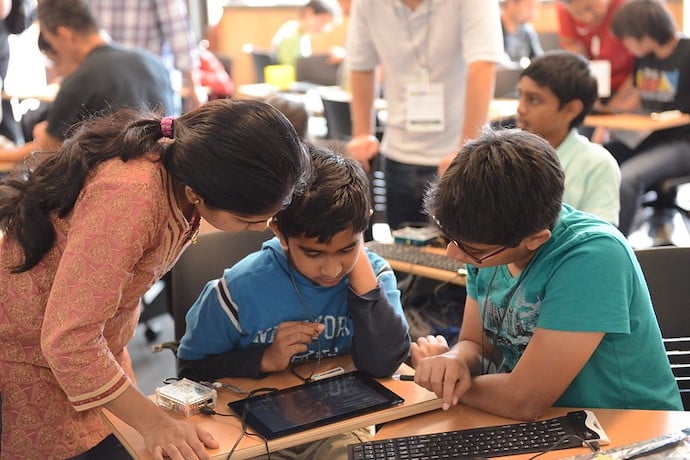Last time we introduced TIC-80, a little all-in-one system for doing games, music, and generative art projects. We talked about the basics of using code to draw, and then we drew a picture of a snowman. This time we are shooting for the stars.
Here is a reminder of the code we finished up with last time.
function TIC()
cls(13)
circ(120,100,22,12)
circb(120,100,22,0)
circ(120,80,18,12)
circb(120,80,18,0)
circ(120,65,13,12)
circb(120,65,13,0)
circ(115,60,2,0)
circ(125,60,2,0)
tri(118,63,122,63,120,70,3)
line(105,80,85,70,0)
line(135,80,155,70,0)
endBelow are the main concepts we will need to move on to our new project.
- there has to be a function called TIC() that acts as the main game loop
- the screen is 240 pixels wide and 136 pixels tall, with (0,0) as the upper-left corner of the screen
- to draw circles you use the circ function, which takes as its arguments the x and y position of the center of the circle, the radius of the circle, and the number of the color as seen in the sprite-making tab
With all those reminders, now we can talk about how to create a moving field of stars, which means
- how to use randomness to create an infinitely varying scene
- how to make things move across the screen
- how to use Lua’s tables as both lists and objects
To start, open TIC-80 and create a new project with new lua, hit esc to see the code, and you should be looking at the basic program that all TIC-80 programs start with. Great, now erase it all so that your file looks like this
function TIC()
endand nothing else.
The first thing we need to do is make a list for holding the stars that are going to scroll down the screen. This is our first use of tables.
stars = {}
function TIC()
end
I’m going to show you a bit of a trick for how to write programs like this. Start by writing what the thing should do and then go back and fill in what you need to do it. So, even though we haven’t figured out what a “star” is in the program, we’re going to figure out what we need it to be by writing our drawing and movement code first.
stars = {}
function TIC()
cls(0) -- we want a black background because space
for i,s in ipairs(stars) do
circ(s.x, s.y, s.r, 13)
s.y = s.y + 0.1
end
end
Okay, we have our basics here now: we’re using
a for .. in .. loop to do something for every star in the list
i,smeans name the place in the list, which is a number, i and grab the actual star in the list and call it sipairs(stars)means “take the Lua table stars and treat it like a list”
the . syntax to get access to data stored in each star; in this case we’re using
s.xas the x positions.yas the y positions.ras the radius of the circle
We can run this code, although it won’t do anything because there are no stars in the list!
So let’s write a function to make new stars.
stars = {}
function makeNewStar
function makeNewStar(top,bottom)
local newStar = {}
newStar.x = math.random(0,239)
newStar.y = math.random(top,bottom)
newStar.r = math.random(0,1)
table.insert(stars,newStar)
end
for i=1,500 do
makeNewStar(0,136)
end
function TIC()
cls(0) -- we want a black background because space
for i,s in ipairs(stars) do
circ(s.x, s.y, s.r, 13)
s.y = s.y + 0.1
end
end
We make a new star just like we made the list of stars, and we set the properties that we want to use. Finally, we put the star in the list with the function table.insert. Of course, we couldn’t draw anything if we didn’t make some stars, so we also add a for loop that runs 500 times and places stars on the screen between 0 and 136. We generate star positions and sizes randomly with the function math.random which can be used to either get a whole number between a range or a fractional number if you give it no argument at all. We’ll come back to that in a moment.
Now if you test this code you’ll see a few problems that we need to fix. First, once the stars scroll down they’re completely gone. That means we need to make new stars as the old ones scroll off the screen. Unlike the first stars, we want to make these above the top of the screen so they scroll into view and don’t just “pop”.
Second, we want the stars to blink: but not all at the same time, so we’re going to add code to make a timer that ticks down so that the stars blink every couple of seconds, but not in sync with each other.
Finally, we want the stars to actually move at different rates to give the feeling that they’re not all the same distance away. Your eye will sort of naturally assume the ones moving slower are further and the ones moving faster are closer, even without explicit layers to draw.
So if we add in all those little changes we get this instead.
stars = {}
function makeNewStar(top,bottom)
local newStar = {}
newStar.x = math.random(0,239)
newStar.y = math.random(top,bottom)
newStar.r = math.random(0,1)
newStar.t = math.random(0,240)
newStar.vy = math.random()/2 + 0.1
table.insert(stars,newStar)
end
for i=1,500 do
makeNewStar(0,136)
end
function TIC()
cls(0)
for i,s in ipairs(stars) do
circ(s.x,s.y,s.r,12)
s.y = s.y + s.vy
if s.t == 0 then
s.r = (s.r + 1)%2
s.t = 240
else
s.t = s.t-1
end
if s.y > 136 then
table.remove(stars,i)
makeNewStar(-20,-5)
end
end
endStay tuned. Next time, we will expand on this program and make it interactive.
Learn More
TIC 80
What is TIC-80?
https://en.wikipedia.org/wiki/TIC-80
Ruby, Lua, or Java for TIC 80
https://www.reddit.com/r/tic80/comments/t57kkx/should_i_learn_lua_ruby_or_javascript/
TIC 80: Learn to Program Games
Animated Sprite in TIC 80
https://www.youtube.com/watch?v=eprXV5arv7A

